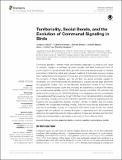Files in this item
Territoriality, social bonds, and the evolution of communal signaling in birds
Item metadata
| dc.contributor.author | Tobias, Joseph A. | |
| dc.contributor.author | Sheard, Catherine | |
| dc.contributor.author | Seddon, Nathalie | |
| dc.contributor.author | Meade, Andrew | |
| dc.contributor.author | Cotton, Alison J. | |
| dc.contributor.author | Nakagawa, Shinichi | |
| dc.date.accessioned | 2018-02-21T15:30:06Z | |
| dc.date.available | 2018-02-21T15:30:06Z | |
| dc.date.issued | 2016-06-24 | |
| dc.identifier | 252359680 | |
| dc.identifier | 57a210b0-ea97-4993-bdbd-d3099c36a0ca | |
| dc.identifier | 85041483713 | |
| dc.identifier.citation | Tobias , J A , Sheard , C , Seddon , N , Meade , A , Cotton , A J & Nakagawa , S 2016 , ' Territoriality, social bonds, and the evolution of communal signaling in birds ' , Frontiers in Ecology and Evolution , vol. 4 , 74 . https://doi.org/10.3389/fevo.2016.00074 | en |
| dc.identifier.issn | 2296-701X | |
| dc.identifier.other | crossref: 10.3389/fevo.2016.00074 | |
| dc.identifier.uri | https://hdl.handle.net/10023/12771 | |
| dc.description | JT was supported by the John Fell Fund and the Natural Environment Research Council. NS was funded by a Royal Society University Research Fellowship. SN was supported by a Royal Society of New Zealand Rutherford Discovery Fellowship and an Australian Research Council Future Fellowship. | en |
| dc.description.abstract | Communal signaling—wherein males and females collaborate to produce joint visual or acoustic displays—is perhaps the most complex and least understood form of communication in social animals. Although many communal signals appear to mediate competitive interactions within and between coalitions of individuals, previous studies have highlighted a confusing array of social and environmental factors that may explain the evolution of these displays, and we still lack the global synthesis needed to understand why communal signals are distributed so unevenly across large taxonomic and geographic scales. Here, we use Bayesian phylogenetic models to test whether acoustic communal signals (duets and choruses) are explained by a range of life-history and environmental variables across 10328 bird species worldwide. We estimate that duets and choruses occur in 1830 (18%) species in our sample and are thus considerably more widespread than previously thought. We then show that global patterns in duetting and chorusing, including evolutionary transitions between communal signaling and solo signaling, are not explained by latitude, migration, climate, or habitat, and only weakly correlated with cooperative breeding. Instead, they are most strongly associated with year-round territoriality, typically in conjunction with stable social bonds. Our results suggest that the evolution of communal signals is associated with the coordinated defense of ecological resources by stable coalitions of males and females, and that other widely reported associations are largely by-products of this underlying trend. | |
| dc.format.extent | 15 | |
| dc.format.extent | 6050541 | |
| dc.language.iso | eng | |
| dc.relation.ispartof | Frontiers in Ecology and Evolution | en |
| dc.subject | Birdsong | en |
| dc.subject | Chorusing | en |
| dc.subject | Cooperation | en |
| dc.subject | Duetting | en |
| dc.subject | Ecological competition | en |
| dc.subject | Resource defense | en |
| dc.subject | Sociality | en |
| dc.subject | QH301 Biology | en |
| dc.subject | QL Zoology | en |
| dc.subject | NDAS | en |
| dc.subject.lcc | QH301 | en |
| dc.subject.lcc | QL | en |
| dc.title | Territoriality, social bonds, and the evolution of communal signaling in birds | en |
| dc.type | Journal article | en |
| dc.contributor.institution | University of St Andrews. School of Biology | en |
| dc.contributor.institution | University of St Andrews. Centre for Biological Diversity | en |
| dc.identifier.doi | https://doi.org/10.3389/fevo.2016.00074 | |
| dc.description.status | Peer reviewed | en |
This item appears in the following Collection(s)
Items in the St Andrews Research Repository are protected by copyright, with all rights reserved, unless otherwise indicated.

